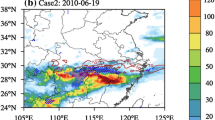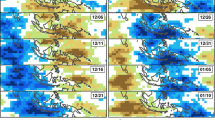Abstract
Mei-yu fronts are accompanied with the formation of frontal clouds. In addition to its direct effect on Mei-yu fronts through the modification of atmospheric temperature, diabatic heating related to clouds formation also influences frontogenesis indirectly by changing local atmospheric circulation. To quantify such indirect effects, piecewise potential vorticity (PV) inversion is adopted to decompose the process of deformation frontogenesis into several parts associated with distinct PV anomalies. The balanced flow associated with the interior-level diabatic PV anomaly emerges as the most stable and important contributor to the total deformation frontogenesis with the effect of local diabatic PV anomaly in the frontal zone outweighing the effect of remote diabatic PV anomaly. Lower-boundary thermal anomaly (i.e., surface cooling associated with frontal clouds formation) and mean flow provide weak negative and positive contributions to the deformation frontogenesis, respectively. The balanced flow associated with the upper-level PV perturbations is weak at lower-levels, especially in the vicinity of the front zone and thus has negligible contributions to the Mei-yu frontogenesis. The indirect effect of diabatic heating on Mei-yu frontogenesis is generally weaker in magnitude compared to the direct effect of temperature modification as well as the impact of moisture depletion that is also tied to clouds formation. The results presented here add further evidences about the importance of cloud feedback to the evolution of Mei-yu fronts and suggest the necessity of improved model representations of cloud processes in achieving a better simulation and prediction of Mei-yu rainfall.













Similar content being viewed by others
Data availability
The ERA5 data is available at https://cds.climate.copernicus.eu/, and the rainfall data is archived at http://data.cma.cn.
References
Ahmadi-Givi F, Graig GC, Plant RS (2004) The dynamics of a midlatitude cyclone with very strong latent-heat release. Q J R Meteorol Soc 130(596):295–323
Baxter MA, Schumacher PN, Boustead JM (2011) The use of potential vorticity inversion to evaluate the effect of precipitation on downstream mesoscale processes. Q J R Meteorol Soc 137(654):179–198
Bretherton FP (1966) Critical layer instability in baroclinic flows. Q J R Meteorol Soc 92:325–334
Büeler D, Pfahl S (2017) Potential vorticity diagnostics to quantify effects of latent heating in extratropical cyclones. Part I: methodology. J Atmos Sci 74(11):3567–3590
Chang CP, Hou SC, Kuo HC, Chen GTJ (1998) The development of an intense East Asian summer monsoon disturbance with strong vertical coupling. Mon Weather Rev 126:2692–2712
Charney JG (1955) The use of primitive equations of motion in numerical prediction. Tellus 7:22–26
Chen GTJ, Chang CP (1980) The structure and vorticity budget of an early summer monsoon trough (Mei-Yu) over southeastern China and Japan. Mon Weather Rev 108:942–953
Chen SJ, Kuo YH, Wang W, Tao ZY, Cui B (1998) A modeling case study of heavy rainstorm along the Mei-Yu front. Mon Weather Rev 126:2330–2351. https://doi.org/10.1175/1520-0493(1998)126%3c2330:AMCSOH%3e2.0.CO;2
Chen GTJ, Wang CC, Liu S (2003) Potential vorticity diagnostics of a Mei-yu front case. Mon Weather Rev 131(11):2680–2696. https://doi.org/10.1175/1520-0493(2003)131%3c2680:PVDOAM%3e2.0.CO;2
Chen GTJ, Wang CC, Lin LF (2006) A diagnostic study of a retreating Mei-Yu front and the accompanying low-level jet formation and intensification. Mon Weather Rev 134(3):874–896. https://doi.org/10.1175/MWR3099.1
Chen GTJ, Wang CC, Wang AH (2007) A case study of subtropical frontogenesis during a blocking event. Mon Weather Rev 135(7):2588–2609. https://doi.org/10.1175/MWR3412.1
Chen GTJ, Wang CC, Chang SW (2008) A diagnostic case study of Mei-yu frontogenesis and development of wavelike frontal disturbances in the subtropical environment. Mon Weather Rev 136(1):41–61. https://doi.org/10.1175/2007MWR1966.1
Cho HR, Chen GTJ (1995) Mei-Yu frontogenesis. J Atmos Sci 52(11):2109–2120
Copernicus Climate Change Service (C3S) (2017) ERA5: fifth generation of ECMWF atmospheric reanalyses of the global climate. Copernicus Climate Change Service Climate Data Store (CDS), Available at https://cds.climate.copernicus.eu/cdsapp#!/home. Accessed 16 Mar 2020
Cui CG, Hu BW, Wang XF, Li SS, Zhou W (2019) Research progress on the equivalent-barotropic shear type Meiyu front heavy rain. Torrential Rain Disast 38(5):541–553
Davis CA (1992) Piecewise potential vorticity inversion. J Atmos Sci 49:1397–1411
Davis CA, Emanuel KA (1991) Potential vorticity diagnostics of cyclogenesis. Mon Weather Rev 119:1929–1953
Ding YH (1992) Summer monsoon rainfalls in China. J Meteorol Soc Jpn 70:373–396
Ertel H (1942) Ein neuer hydrodynamischer wirbelsatz. Meteorol Z 59:271–281
Fu SM, Sun JH, Sun JR (2014) Accelerating two-stage explosive development of an extratropical cyclone over the northwestern northwestern Pacific Ocean: a piecewise potential vorticity diagnosis. Tellus 66A:23210. https://doi.org/10.3402/tellusa.v66.23210
Fu SM, Sun JH, Li WL et al (2018) Investigating the mechanisms associated with the evolutions of twin extratropical cyclones over the northwest Pacific Ocean in mid-January 2011. J Geophys Res Atmos 123(8):4088–4109
Gao ST, Yang S, Xue M, Cui CG (2008) Total deformation and its role in heavy precipitation events associated with deformation-dominant flow patterns. Adv Atmos Sci 25(1):11–23. https://doi.org/10.1007/s00376-008-0011-y
Holton JR (2004) An introduction to dynamic meteorology, 4th edn. Elsevier Academic Press, Burlington, MA, p 271
Hoskins B, McIntyre ME, Robertson AW (1985) On the use and significance of isentropic potential vorticity maps. Q J R Meteorol Soc 111(466):877–946
Hu Y, Deng Y, Zhou ZM, Cui CG, Dong XQ (2019) A statistical and dynamical characterization of large-scale circulation patterns associated with summer extreme precipitation over the middle reaches of Yangtze river. Clim Dyn 52(9):6213–6228. https://doi.org/10.1007/s00382-018-4501-z
Hu Y, Deng Y, Lin YL, Zhou ZM, Cui CG, Dong XQ (2021) Dynamics of the spatiotemporal morphology of Mei-yu fronts: an initial survey. Clim Dyn 56:2715–2728. https://doi.org/10.1007/s00382-020-05619-2
Jiang T, Deng Y (2011) Downstream modulation of North Pacific atmospheric river activity by East Asian cold surges. Geophys Res Lett 38:L20807. https://doi.org/10.1029/2011GL049462
Lackmann GM (2002) Cold-frontal potential vorticity maxima, the low-level jet, and moisture transport in extratropical cyclones. Mon Weather Rev 130:59–74
Lu Y, Deng Y (2015) Initial transient response of an intensifying Baroclinic wave to increase in cloud droplet number concentration. J Clim 28:9669–9677. https://doi.org/10.1175/JCLI-D-15-0251.1
Luo Y, Wang H, Zhang RH, Qian WM, Luo ZZ (2013) Comparison of rainfall characteristics and convective properties of monsoon precipitation systems over South China and the Yangtze and Huai River Basin. J Clim 26:110–132
Morgan MC (1999) Using piecewise potential vorticity inversion to diagnose frontogenesis. Part I: a partitioning of the Q vector applied to diagnosing surface frontogenesis and vertical motion. Mon Weather Rev 127(12):2796–2821
Nie J, Fan BW (2019) Roles of dynamic forcings and diabatic heating in summer extreme precipitation in East China and the Southeastern United States. J Clim 32:5815–5831. https://doi.org/10.1175/JCLI-D-19-0188.1
Nie J, Sobel AH (2016) Modeling the interaction between quasigeostrophic vertical motion and convection in a single column. J Atmos Sci 73(3):1101–1117. https://doi.org/10.1175/JAS-D-15-0205.1
Nie J, Shaevitz DA, Sobel AH (2016) Forcings and feedbacks on convection in the 2010 Pakistan flood: modeling extreme precipitation with interactive large-scale ascent. J Adv Model Earth Syst 8:1055–1072. https://doi.org/10.1002/2016MS000663
Nie J, Sobel AH, Shaevitz DA, Wang SG (2018) Dynamic amplification of extreme precipitation sensitivity. Proc Natl Acad Sci 115:9467–9472. https://doi.org/10.1073/pnas.1800357115
Ninomiya K (1984) Characteristics of baiu front as a predominant subtropical front in the summer northern hemisphere. J Meteorol Soc Jpn 62(6):880–894
Ninomiya K, Shibagaki Y (2003) Cloud system families in the Meiyu-Baiu front observed during 1–10 July 1991. J Meteorol Soc Jpn Ser II 81(2):193–209
Reed RJ, Stoelinga MT, Kuo YH (1992) A model-aided study of the origin and evolution of the anomalously high potential vorticity in the inner region of a rapidly deepening marine cyclone. Mon Weather Rev 120:893–913
Shen Y, Zhao P, Pan Y, Yu JJ (2014) A high spatiotemporal gauge-satellite merged precipitation analysis over China. J Geophys Res Atmos 119(6):3063–3075
Spengler T, Egger J (2012) Potential vorticity attribution and causality. J Atmos Sci 69(8):2600–2607. https://doi.org/10.1175/JAS-D-11-0313.1
Stoelinga MT (1996) A potential vorticity-based study of the role of diabatic heating and friction in a numerically simulated baroclinic cyclone. Mon Weather Rev 124:849–874
Tochimoto E, Kawano T (2012) Development processes of Baiu frontal depressions. SOLA 8:9–12
Tochimoto E, Kawano T (2017) Numerical investigation of development processes of Baiu frontal depressions. Part I: case studies. J Meteorol Soc Jpn 95:91–109
Wang CC, Chen GTJ, Ho KH (2016) A diagnostic case study of Mei-Yu frontal retreat and associated low development near Taiwan. Mon Weather Rev 144(6):2327–2349. https://doi.org/10.1175/MWR-D-15-0391.1
Wang XK, Zhou RJ, Deng Y, Cui CC, Hu Y, Wang JY, Liu H (2021) Symbiotic relationship between meiyu rainfall and the morphology of Meiyu front. J Hydrometeorol. https://doi.org/10.1175/JHM-D-21-0068.1
Xie ZW, Black RX, Deng Y (2019) Planetary and synoptic-scale dynamic control of extreme cold wave patterns over the United States. Clim Dyn 53:1477–1495. https://doi.org/10.1007/s00382-019-04683-7
Xue M, Luo X, Zhu KF, Sun ZQ, Fei JF (2018) The controlling role of boundary layer inertial oscillations in Meiyu frontal precipitation and its diurnal cycles over China. J Geophys Res Atmos 123(10):5090–5115
Yang S, Gao ST, Lu CG (2014) A generalized frontogenesis function and its application. Adv Atmos Sci 31(5):1065–1078. https://doi.org/10.1007/s00376-014-3228-y
Yang S, Gao ST, Lu CG (2015) Investigation of the mei-yu front using a new deformation frontogenesis function. Adv Atmos Sci 32(5):635–647. https://doi.org/10.1007/s00376-014-4147-7
Zhao Y, Chen DL, Deng Y, Son SW, Wang X, Di D, Pan MT, Ma XD (2021) How were the eastward-moving heavy rainfall events from the Tibetan Plateau to the lower reaches of the Yangtze River enhanced? J Clim 34(2):607–620
Zhou YS, Gao ST, Shen SSP (2004) A diagnostic study of formation and structures of the Meiyu front system over East Asia. J Meteorol Soc Jpn 82(6):1565–1576
Acknowledgements
The authors thank Dr. Christopher Davis, Dr. Shenming Fu and Prof. Wenyu Huang for providing the PV inversion code and valuable suggestions on its application. This study was supported by the National Natural Science Foundation of China (Grant nos. 41905071, 41620104009), the National Key Research Project of China (Grant 2018YFC1507001), the Research fund for Weather modification ability construction project of Northwest China (ZQC-R18169/RYSY201904) and the Technology Development Project of Hubei Meteorological Service (2021Y04). Yi Deng is in part supported by the U.S. National Science Foundation (NSF) through Grant AGS-2032532 and by the U.S. National Oceanic and Atmospheric Administration (NOAA) through Grant NA20OAR4310380.
Author information
Authors and Affiliations
Corresponding authors
Ethics declarations
Conflict of interest
The authors have no conflicts of interest to declare that are relevant to the content of this article.
Additional information
Publisher's Note
Springer Nature remains neutral with regard to jurisdictional claims in published maps and institutional affiliations.
Appendix
Appendix
Based on the non-divergent approximation (\(\mathrm{V}\approx {\mathrm{V}}_{\psi }=\mathrm{k}\times \nabla\Psi\)), hydrostatic balance assumption (\(\partial\Phi /\partial \pi =-\theta\)) and a “full” linearization method (see Davis and Emanuel 1991; Davis 1992 for details), the perturbation equations to perform the piecewise PV inversion are:
where \({q}_{n}\) is a specific PV anomaly; \({\Phi }_{n}\) the geopotential anomaly; \({\Psi }_{n}\) the non-divergent streamfunction anomaly; \(f\) the Coriolis parameter; \(a\) the radius of the Earth; \(\varphi\) the latitude; \(\lambda\) the longitude; \(\pi ={{\mathrm{C}}_{p}(p/{p}_{0})}^{{\mathrm{C}}_{p}/R}\) is the Exner function. \({\Psi }^{*}\) and \({\Phi }^{*}\) are defined by the mean plus half of the total anomaly, i.e., \({\left[\right]}^{*}=\left[\stackrel{-}{}\right]+\frac{1}{2}{\sum }_{n=1}^{N}{\left[\right]}_{n}\). Given the three-dimensional distribution of \({q}_{n}\) and the boundary conditions (i.e., the Neumann conditions at lower and upper boundaries and Dirichlet conditions on the lateral boundaries), the two equations (i.e., 8, 9) with two unknowns (i.e., \({\Phi }_{n}\),\({\Psi }_{n}\)) can be solved through iteration.
Rights and permissions
About this article
Cite this article
Hu, Y., Deng, Y., Lin, Y. et al. Indirect effect of diabatic heating on Mei-yu frontogenesis. Clim Dyn 59, 851–868 (2022). https://doi.org/10.1007/s00382-022-06159-7
Received:
Accepted:
Published:
Issue Date:
DOI: https://doi.org/10.1007/s00382-022-06159-7




